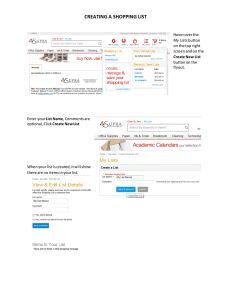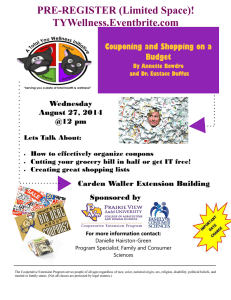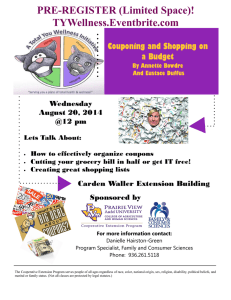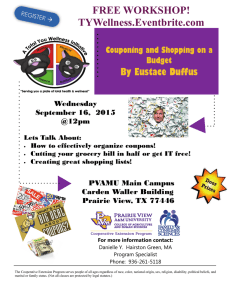A. Reading KINDS OF SHOPPING ---------------------------------------------------------------------------------
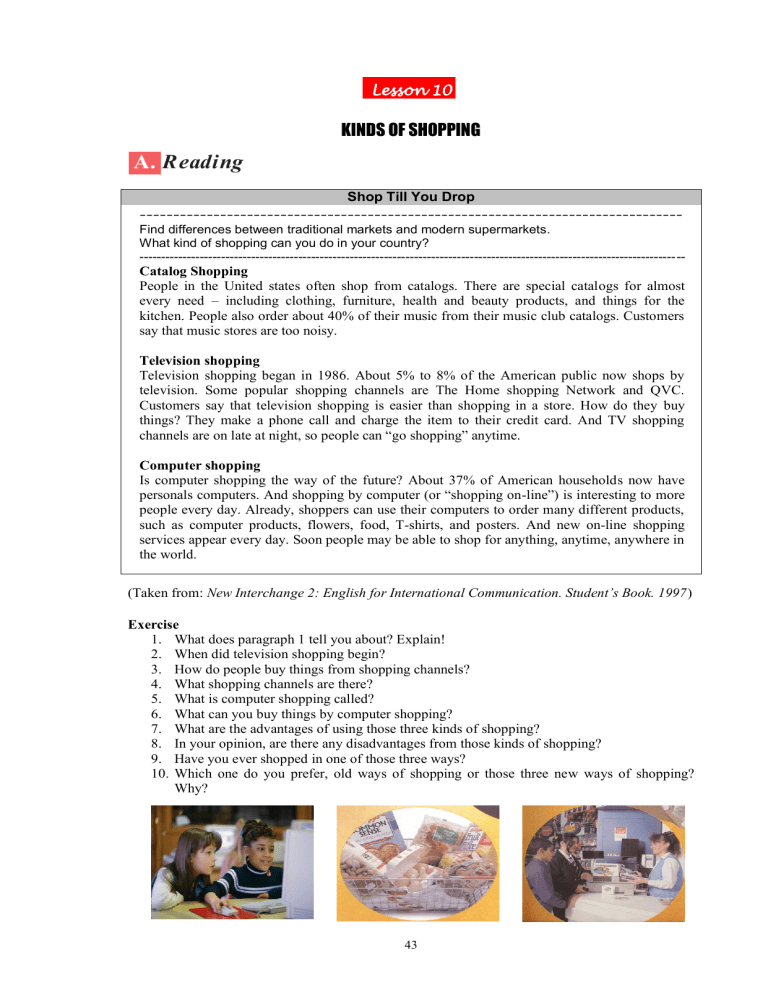
Lesson 10
KINDS OF SHOPPING
A.
Reading
Shop Till You Drop
---------------------------------------------------------------------------------
Find differences between traditional markets and modern supermarkets.
What kind of shopping can you do in your country?
----------------------------------------------------------------------------------------------------------------------------- --
Catalog Shopping
People in the United states often shop from catalogs. There are special catalogs for almost every need – including clothing, furniture, health and beauty products, and things for the kitchen. People also order about 40% of their music from their music club catalogs. Customers say that music stores are too noisy.
Television shopping
Television shopping began in 1986. About 5% to 8% of the American public now shops by television. Some popular shopping channels are The Home shopping Network and QVC.
Customers say that television shopping is easier than shopping in a store. How do they buy things? They make a phone call and charge the item to their credit card. And TV shopping channels are on late at night, so people can “go shopping” anytime.
Computer shopping
Is computer shopping the way of the future? About 37% of American households now have personals computers. And shopping by computer (or “shopping on-line”) is interesting to more people every day. Already, shoppers can use their computers to order many different products, such as computer products, flowers, food, T-shirts, and posters. And new on-line shopping services appear every day. Soon people may be able to shop for anything, anytime, anywhere in the world.
(Taken from: New Interchange 2: English for International Communication. Student’s Book. 1997 )
Exercise
1.
What does paragraph 1 tell you about? Explain!
2.
When did television shopping begin?
3.
How do people buy things from shopping channels?
4.
What shopping channels are there?
5.
What is computer shopping called?
6.
What can you buy things by computer shopping?
7.
What are the advantages of using those three kinds of shopping?
8.
In your opinion, are there any disadvantages from those kinds of shopping?
9.
Have you ever shopped in one of those three ways?
10.
Which one do you prefer, old ways of shopping or those three new ways of shopping?
Why?
43
The Kinds of Shoping
44
B.
Vocabulary
Abbreviations and Others
Exercise 1
Match the abbreviations in the left column with their corresponding explanation in the right. Check with your dictionary to help you.
1. ISBN
2. FAO
3. TKO
4. RSVP
5. VIP
6. OPEC
7. EEC
8. UFO
9. BBC
10. SOS
11. SAR
12. GATT
13. GMT
14. RIP
15. COD
A. international time
B. international book number
C. international organization related to food
D. flying in space
E. payment at home
F. radio broadcasting station
G. European organization related to economy
H. a term in boxing or fighting sports
I. international agreement on tariffs and trade
J. dead
K. team to search and help troubled people
L. international oil organization
M. very special persons
N. answer please
O. please help us
Exercise 2
Match the abbreviations in the left column with their corresponding meaning in the right.
Check with your dictionary to help you.
1. Inc.
2. et. al.
3. etc.
4. a.m.
5. e.g.
6. Ltd.
7. i.e.
8. cf.
9. pto
10. vs. a. that is, namely b. compare c. company d. in the morning e. against f. please turn over g. limited h. and others i. and so on j. for example
Exercise 3
Match the symbols in the left column with their corresponding meaning in the right. Check with your dictionary or other reference books.
1. #
2. &
3. !
4. ©
5.
6. >
7. ¶
8.
9.
10. a. more than b. cut here c. information d. watch out e. sum, total f. number g. and h. unlimited amount i. new paragraph j. copy right
The Kinds of Shoping
45
C.
G rammar
Content Clauses
We often meet this type of sentences:
I understand that I must return the books on time.
She said that she was leaving for the holiday.
We know where he lives.
In the grammar of a language, these sentences are called content clauses or noun clauses .
Remember that we have studied adjective clauses in the lesson about noun phrases. Sometimes, it is necessary to be able to differentiate between these two constructions.
Adjective clauses are those which function as qualifiers of a head word. A noun clause, however, functions as a noun. It stands by itself as a noun. It does not qualify another noun.
We also have studied about the forms and functions of nouns. Nouns can be subjects, objects, or complements in sentences. They can also come after prepositions. The same thing can happen to noun clauses. Noun clause can be subjects, objects, or complements of sentences. They can also become objects of prepositions. Study the following examples.
Function
Subject
Object
Examples
Who finishes first will get a present.
What goes up must come down.
They think that the test is on the next day.
You may decide what time you want to go.
Complement Love is what you can give.
It seems what it looks.
Object to preposition We talked about what it seemed to be the right solution.
You can speak to whoever you meet first.
As we have learned earlier, again, this construction is not a question form. It is a subordinate clause. It has the grammar of a positive sentence, not an interrogative sentence. Compare these below?
(1) What time do you want to go?
( do ) + inversion question mark
(2) You may decide what time you want to go.
no inversion no question mark
In the first sentence, (1), we have the rules for forming the question: the use of the auxiliary do , the inversion of the subject and predicate, and the question mark at the end of the question. But in the second sentence, (2), we do not have the interrogative rules. It is an ordinary affirmative sentence. Look again:
(1) … what time do you want to go?
(2) … what time you want to go.
The Kinds of Shoping
46
Exercise 1
Identify which one is the noun clause.
1. a) I like the book that you bought for me yesterday. b) They know that you bought a book for me yesterday.
2. a) The director has made an announcement that makes everybody worried. b) The director has announced what makes everybody worried.
3. a) I can decide wherever I want to go. b) I made a decision that made everybody surprised.
4. a) The students spoke to the person who was responsible for the event. b) The students have spoken to who is supposed to be responsible for the event.
5. a) Somebody please tell me about what has happened here? b) Somebody has told me about the accident that happened here.
Exercise 2
Change these into sentences that have a noun clause like the ones above.
1. The teacher asked: ”What do you want?”
2. He said: “None of my friends would want to come with me.”
3. The secretary understands his jobs well. (The secretary understands what …)
4. She promised: “You will get a nice birthday present.”
5. The manager explains something the company is going to do. (The manager explains what …)
6. I asked the shopkeeper: “How much does a second-hand monitor unit cost?”
7. They explained the reason for cancelling the show. (They explained why …)
8. Somebody at the back shouted: “I don’t agree with your opinion.”
9. We know the person who will become a good leader.
10. My friend answered: “I came late because I had a flat tire.” (My friend answered why …)

